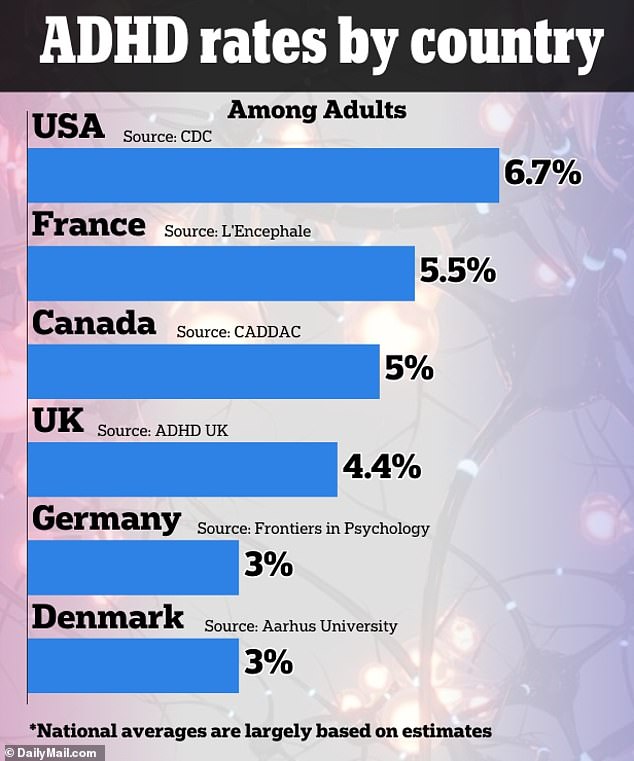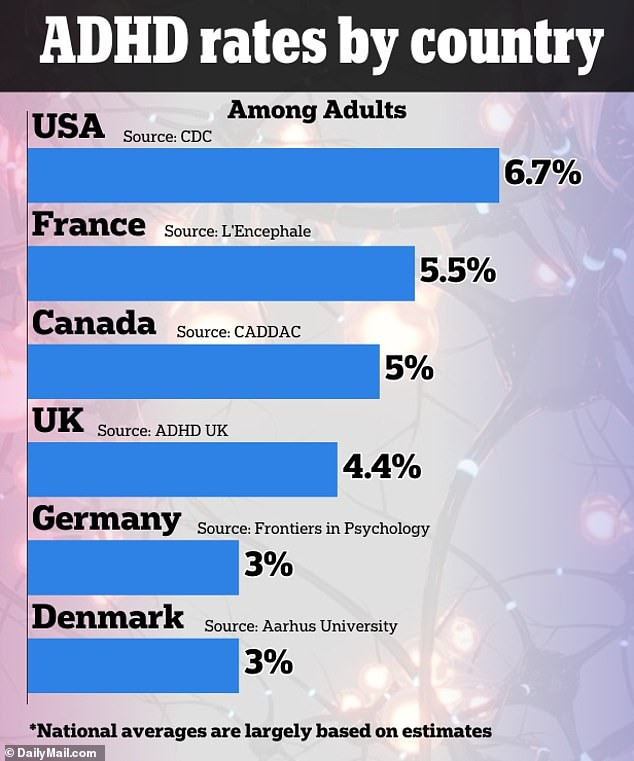CDC statistics reveal a surprising number of people with ADHD in America compared to other countries



One in 16 adults in the U.S. lives with ADHD, according to a new CDC report.
It found that 15.5 million people over the age of 18 had the condition (6 percent), which as a percentage is much higher than in other countries such as Britain, where about 4.4 percent of adults have the condition, or Germany, where it is 3 percent.
The new report was the first national estimate of ADHD in adults in decades, so the CDC spokesperson said they cannot confirm whether diagnoses have increased.
But experts told DailyMail.com that what they are seeing in their clinics is clear: more people are coming in to get tested and the number of ADHD diagnoses is increasing overall.
This has to do with a number of factors – including misdiagnoses in childhood – experts tell DM.com. Separate figures show that one in seven Americans under the age of 18 are diagnosed with the condition, which is also much higher than in comparable countries.

The rate of ADHD diagnoses in adults in the US appears to be higher than in other Western countries, mirroring similar trends seen in children
Dr. Justin Barterian, a psychologist at Ohio State University, told DailyMail.com, “I think the number of people seeking a diagnosis has increased, which has resulted in more diagnoses.”
They suggest this has to do with a number of factors, including: the explosion of telehealth, making it easier to get tested for ADHD, increased awareness about the disorder through social media influencers, and adults becoming curious after seeing how their children were diagnosed with ADHD. .
Around the world, about two to five percent of adults are affected by ADHD, and the US typically ranks at the top.
In Canada, estimates set the rate between 4 and 6 percent – while in Germany And Denmark rates are around 3 percent. The most recent French estimates are approximately 5.5 percent.
The new data comes from the National Center for Health Statistics Rapid Surveys System, which calls people at their homes and asks them to self-report their health data.
Their goal is to get a sample large enough and diverse enough to reflect the demographic makeup of the US.
Prior to this report, estimated rates of current ADHD in adults were based on 2003 data.
However, older reports have shown that prescriptions for ADHD medications like Adderall are steadily increasing. In 2021, 41 million prescriptions were filled.
At the same time, Dr. Barterian said he and his colleagues have seen an influx of new patients seeking ADHD testing. He said doctors at other clinics made patients wait for months before being tested.
Their report defined more details about what life is like for people with ADHD. More than half of these individuals are diagnosed as children.
About 62 percent of all cases involve people who are currently between 25 and 49 years old.
It found that a third of these people – about 5 million – are taking medications like Adderall to control their symptoms. But 71.5 percent of people reported having trouble filling their prescriptions, largely due to labor shortages at pharmaceutical manufacturers.
Dr. Barterian said this affected patients at his clinic, who then struggled to perform at work, concentrate at school or even do household chores.
Yet 36 percent of people do not seek treatment at all for their diagnosis.

The number of Adderall prescriptions has steadily increased over the past twelve years. The figures include prescriptions for both Adderall, branded and generic, in the US
Although the CDC report seemed consistent with what clinicians are experiencing, Dr. Barterian cautioned that using a self-reported survey could introduce some errors into the data.
For example, someone could have answered that they had ADHD, even though they had not yet confirmed that diagnosis with a doctor. Or someone with ADHD may have omitted that information when completing the survey.
This means that the numbers found here could be higher or lower than we know.
Dr. Rebecca Mannis, a learning specialist who has studied neuropsychology and helps people with learning difficulties such as ADHD and dyslexia, told DailyMail.com that the condition is likely more common in adults because their diagnosis was missed when they were younger.
“ADHD is over- and under-diagnosed,” she said. This means that there are some people who have been diagnosed when they could have had another condition, such as autism or anxiety.
But others are still ignored, if they are good enough at managing their symptoms and staying under the radar.
These people, who go unnoticed as children, sometimes develop greater problems concentrating or managing tasks as adults, and then eventually come to her office, where she helps them learn time management skills.




